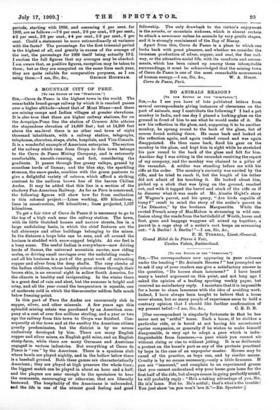A MOUNTAIN CITY OF PERU.
rTo THE EDITOE OF THZ " SPECTATOR."1 SIR,—Cerro de Pasco is the highest town in the world. The remarkable broad-gauge railway by which it is reached passes over a higher altitude—about that of Mont Blanc—and there are mining camps and Indian villages at greater elevations. It is also true that there are higher railway stations, for on the Arequipa-Puno line the station of Crucero Alto attains the stupendous elevation of 14,660 feet ; but at 14,200 feet above the sea-level there is no other real town of eight thousand inhabitants, with a railway station, telegraphs, telephones, churches, shops, clubs, hospitals, and Vice-Consuls. It is a wonderful example of American enterprise. The section of the railway which runs from Oroya to this town belongs to the Cerro de Pasco Mining Company, and is extremely comfortable, smooth-running, and fast, considering the gradients. It passes through fine grassy valleys, grazed by countless herds of llamas; and the blue sky, the sparkling streams, the snow-peaks, combine with the green pastures to give a delightful variety of colours, which afford a striking contrast to the uniform brown hue of the barren Chilian Andes. It may be added that this line is a section of the shadowy Pan-American Railway. As far as Peru is concerned, the following figures will show how far from realisation is this colossal project :—Lines working, 430 kilometres ; lines in construction, 596 kilometre,s ; lines projected, 1,527 kilOmetres.
To get a fair view of Cerro de Pasco it is necessary to go to the top of a high rock near the railway station. The town, with its little thatched houses and narrow streets, lies in a large undulating basin, in which the chief features are the tall chimneys and other buildings belonging to the mines. In the distance a large lake can be seen, and all around the horizon is studded with snow-capped heights. At our feet is a busy scene. The useful Indian is everywhere—now driving herds of llamas, the universal mountain carrier, now riding mules, or driving small carriages over the undulating roads— and all his busiuess is a part of the great work of extracting copper and silver from the deep shafts. The rosy cheeks of the Indian children, whose healthy colour shines through their brown skin, is an unusual sight in sallow South America, for the climate is healthy and invigorating. In the winter there is a great deal of rain and sleet, but the summer is bright and crisp, and all the year round the temperature is equable, one of moderate cold in which the thermometer seldom falls much below freezing-point.
In this part of Peru the Andes are enormously rich in copper, silver, and other minerals. A few years ago this splendid mining estate was purchased by an American com- pany at a cost of over five millions sterling, and a year or two ago the railway from this town to Oroya was finished. Con- sequently at the town and at the smeltry the American citizen greatly predominates, but the district is by no means exclusively developed by him. There are many English copper and silver mines, an English gold mine, and an English sheep-farm, while there are many Germans and Austrians engaged in various industries. But everything at Cerro de Pasco is " run " by the American. There is a spacious club where bowls are played nightly, and in the hollow below there is a baseball ground. Both these games are characteristically American; they are played at high pressure the whole time; the biggest match can be played in about an hour and a half, and the players are near enough to the spectators to hear the comments, encouraging or otherwise, that are liberally bestowed. The hospitality of the Americans is unbounded, and the life is one of the utmost good feeling and good
fellowship. The only drawback to the visitor's enjoyment is the earache, or mountain sickness, which is almost certain to attack a newcomer unless he ascends by very gentle stages, and it is strongly reminiscent of the Bay of Biscay.
Apart from this, Cerro de Pasco is a place to which one looks back with great pleasure, and whether we consider the immense production of silver, copper, and coal, the fine rail- way, or the attractive social life, with its comforts and amuse- ments, which has been raised up among these inhospitable surroundings, it must be acknowledged that the mining town of Cerro de Pasco is one of the most remarkable monumenta








































 Previous page
Previous page